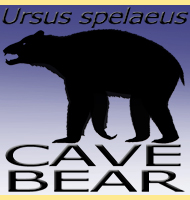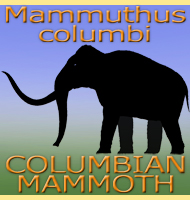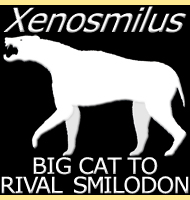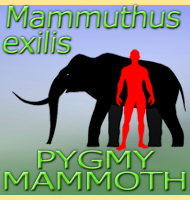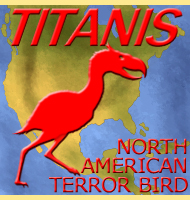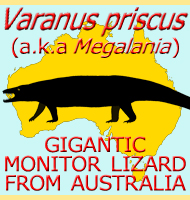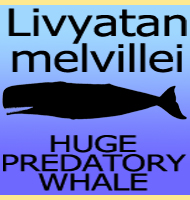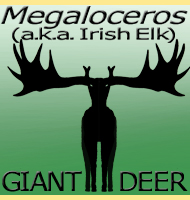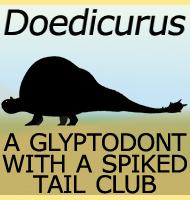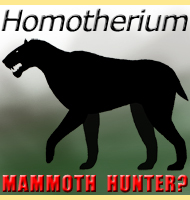


Arctodus
(Short faced bear)
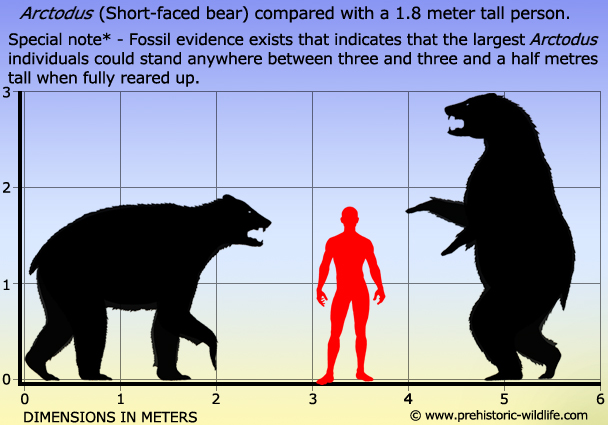
Name: Arctodus
(Bear tooth).
Phonetic: Ark-toe-dus.
Named By: Joseph Leidy - 1854.
Synonyms: Tremarctotherium.
Classification: Chordata, Mammalia, Carnivora,
Ursidae, Tremarctinae, Tremarctini.
Species: A. pristinus
(type), A.
simus.
Diet: Omnivore.
Size: About 1.6 to 1.8 meters tall at the
shoulder, when on
all fours. Weight estimated at up to 800 kg.
Known locations: Throughout North America.
Time period: Pleistocene.
Fossil representation: Multiple specimens.
Arctodus is not a very well-known name, but this ursine has appeared repeatedly in the popular media under the more common name of ‘Short faced bear’. Arctodus is closely related to another similar bear called Arctotherium which is known from South America. While larger specimens (thought to be mature males) of Arctodus may have been slightly larger in terms of skeletal size, Arctotherium had a more robust build that made it the heavier, and thus larger bear.
Arctodus -
predator or
scavenger?
With
such an immense size and obviously powerful jaws it’s tempting to paint
a picture of Arctodus as an apex predator that
could kill anything it
wanted. However, real science is not based upon assumptions that
are established upon superficial glances but on in depth study of the
available fossil material. With this in mind the analysis of Arctodus
remains has led to a surprising but very plausible theory about its
nature and behaviour.
Many
Pleistocene mammal fossils have been subjected to a process termed
oxygen isotope analysis. This is based upon the principal that
different environments have different isotope levels which get absorbed
by the plants growing on them. As these plants are eaten the isotopes
are absorbed and stored in the herbivores tissues as a marker that
allows palaeontologists to establish which types of animal were active
in which environment and what they were eating. In turn as these
herbivores were killed and eaten by carnivores the isotopes get
re-absorbed into the carnivores’ bodies which reveal roughly which
animals were being eaten by which carnivores (for example the sabre
toothed cat Smilodon
seems to have had a preference for bison).
The
analysis for Arctodus shows that it was what is
termed a
hypercarnivore, an animal that has a diet where seventy to a hundred
per cent of the eaten food is the tissue from other animals. However
it also revealed that Arctodus ate all kinds of
animals, and did not
specialise in just one type of prey, something that is highly unusual
for a predator, but quite normal for a scavenger.
The
skeleton also reveals hints to both the travelling and predatory
ability of Arctodus, with special reference to
the long limbs.
These could be seen as giving Arctodus a
significant reach advantage
that allowed it to swipe at prey animals, but the problem here is
that first Arctodus would have to get close enough
to its prey to do
this. In terms of speed the long legs with their broad strides are
thought to have given Arctodus a top speed
approaching fifty kilometres
an hour, something that would have seen it able to comfortably match
most of the available prey species.
However
these same legs are proportionally much thinner than they are in other
running animals, and are considered too fragile to be able to support
a heavy animal like Arctodus if it made a sharp
turn when running at
speed. This could mean an injury such as a break or dislocation that
probably would have been serious enough to cause the death of the
injured bear as it could no longer move about. But it is actually
these long legs that further support the scavenger theory as since they
are lightweight they would not require a great amount of effort to
move. Additionally the long sweeping arc of the feet meant that
Arctodus could comfortably cover more ground with
each step, making
locomotion such as walking or even running extremely energy efficient.
This means that Arctodus could cover territories
that spanned several
hundred square kilometres on a reduced amount of food than would be
required by a dedicated predator. This is a vital survival adaptation
when you consider that a scavenger does not know when or where its next
meal is coming from.
Another
clue comes from the immense size of the body. Arctodus simus
was the
largest carnivorous mammal currently known from Pleistocene North
America, and possibly the largest carnivorous animal since dinosaurs
like Tyrannosaurus disappeared at the end of the
Cretaceous period.
As such it’s extremely unlikely that the other Pleistocene predators
would have put up much of a fight and risked injury or even death from
a more powerful animal. This behaviour has been well documented in
modern times where grizzly bears will walk in and steal kills away from
packs of grey wolves that let the more powerful predator take what it
wants rather than risking injury.
The
final support for Arctodus being a scavenger comes
from the skull.
Arctodus is known as the short faced bear because
its snout is
proportionately shorter than that of other bear genera. These means
that when food is placed in the mouth it is nearer the fulcrum (point
of articulation) of the skull and mandible (lower jaw). This
focuses a greater amount of pressure from the jaw muscles onto whatever
is between the jaws, and seems to have been an adaptation that
allowed Arctodus to crack open bones to get at the
marrow within them.
This is another key survival adaptation as Arctodus
would inevitably
come across carcasses that had already been picked clean, but the
bones still in place because the predators that killed the animal were
unable to crunch the bones open. Even more critical to survival is
the fact that bone marrow can remain nutritious for months and even
years after an animal dies, something that would help Arctodus
to
survive even when there were no fresh kills to steal. Also fossil
evidence of large bison bones exist that look like they have been
bitten open by an animal like Arctodus, a feat
that would be beyond
the scope of smaller predators like wolves.
Arctodus
also had a proportionately large nasal opening in the front of its
skull which indicates that it was capable of sampling a larger volume
of air for scents. This coupled with the bears larger size meant that
it could sniff out and sample scents that were being carried higher
up, possibly to the point of detecting a carcass from several
kilometres away by smell alone. All of these factors combined point
to the short faced bear Arctodus being a much
specialised scavenging
animal.
Evidence
and studies now also suggest that Arctodus was
likely
omnivorous like modern bear species.
Why the short faced bear Arctodus
and the other megafauna became extinct.
Bearing
in mind the almost certain possibility that Arctodus
was a specialised
scavenger it would have been reliant upon two things. The first is
the presence of other large mammals that could provide enough
sustenance to live on, and the second is other predators powerful
enough to kill them. The end of the Pleistocene age in North America
is marked by a disappearance of the megafauna that had for a long time
populated this continent. Not only does this mean that everything
from mammoths to camels went extinct, but most of the larger and
more powerful predators such as Smilodon, the American
Lion and Dire
wolves also declined and eventually disappeared
because there was no
more large prey for them to hunt. With the loss of both factors
critical to the survival of Arctodus gone, it was
only a matter of
time before it followed them into extinction.
How
this extinction happened is a controversial subject as there is no one
explanation that comfortably covers the whole extinction. One is that
the last glaciation of the Pleistocene finished the megafauna. The
problem here is that this was but one of eleven major glaciation
periods that occurred throughout the Pleistocene, with the previous
ten not eradicating the megafauna. With this in mind either the last
glaciation was exceptionally severe, something that is partially
supported by analysis of ice cores, or it was not the only reason.
Perhaps
the most popular theory that supports this extinction is the appearance
of human settlers who had crossed over the Bering land bridge from
Asia. These people are known as ‘Clovis people’ because of their
use of Clovis points that tipped wooden spears that these people
launched from special spear throwers called an atlatl. These weapons
combined with human intelligence would have made the Clovis people the
most formidable hunters to so far set foot upon North America.
How
the Clovis people interacted with their environment is a further matter
of controversy as some researchers believe that they went upon a
killing spree across North America that wiped out the traditional prey
species like mammoth and camel, with several fossil sites showing
human butchering of carcasses. Another theory is that the carnivores
like Smilodon were deliberately eradicated to remove them as
competition to the available prey, although to date there is no
evidence to suggest that the Clovis people did this. Today neither of
these theories is widely accepted as while Clovis people did hunt the
animals of North America, there is insufficient evidence to suggest
that they alone hunted the megafauna into extinction. Also early
humans managed to live in other areas of the world alongside other
megafauna for much longer.
The
reality is probably a combination of the above two events. Animals
had survived previous glaciations before, but times would still have
been hard with the sick, old and weak being more susceptible to
succumbing to the harsh climatic conditions of the time. This likely
meant that the Clovis people that were also trying to survive only had
access to reduced populations of animals, which meant that their
actions would have had a greater long term impact as fewer animals were
surviving to reproduce. Additionally factor in the presence of other
carnivorous animals and you get a picture of an ecosystem that is
stressed beyond its ability to support such a large and diverse range
of creatures.
With
the large prey species reduced to numbers that they could not recover
from and dying out, the larger predators were unable to hunt the
smaller and more agile prey animals and also began to decline and
disappear as well. With no more large scale kills to steal,
Arctodus too disappeared from the landscape. The
Clovis people by
contrast could hunt any size of animal with their spears, and had the
intelligence to adapt accordingly to different challenges. Also the
smaller cousin of the short faced bear, the grizzly (Ursus
arctos
horribilis) is an opportunistic omnivore that explores its
environment to eat everything from fruits, to insects to even
occasionally killing its own prey. This adaptability is why the
grizzly survived this time, and the over specialised Arctodus
disappeared.
Further reading
- A new record of giant short-faced bear, Arctodus simus,
from western
North America with a re-evaluation of its paleobiology. - Contributions
in Science, Natural History Museum of Los Angeles County 371:1-12. - S.
D. Emslie & N. J. Czaplewski - 1985.
- The short-faced bear Arctodus simus from the late
Quaternary in the
Wasatch Mountains of central Utah. - Journal of Vertebrate Paleontology
12(1):107-112. - D. D. Gillette & D. B. Madsen - 1992.
- Arctodus simus from the Alaskan Arctic Slope. - Canadian Journal of
Earth Sciences 30(5):1007-1013, collected by A. V. Morgan - C. S.
Churcher, A. V. Morgan & L. D. Carter - 1993.
- Distribution and size variation in North American short-faced bears,
Arctodus simus. - Paleoecology and paleoenvironments
of Late Cenozoic
mammals 191-246. - R. Richards, C. S. Churcher & W. D. Turnbull
- 1996.
- What size were Arctodus simus and Ursus
spelaeus (Carnivora:
Ursidae)? - Annales Zoologici Fennici 36: 93–102. - Per Christiansen -
1999.
- A partial short-faced bear skeleton from an Ozark cave with comments
on the paleobiology of the species. - Journal of Cave and Karst Studies
65(2):101-110. - B. W. Schubert and J. E. Kaufmann - 2003.
- Ecomorphological correlates of craniodental variation in bears and
paleobiological implications for extinct taxa: an approach based on
geometric morphometrics - Journal of Zoology Volume 277, Issue 1, pages
70–80 - B. Figueirido, P. Palmqvist & J. A. P�rez-Claros - 2010.
- Demythologizing Arctodus simus, the ‘short-faced.
- Journal of
Vertebrate Paleontology 30 (1): 262–275. - Borja Figueirido, Juan A.
P�rez-Claros, Vanessa Torregrosa, Alberto Mart�n-Serra & Paul
Palmqvist - 2010.
- Giant short-faced bear (Arctodus simus) from late
Wisconsinan
deposits at Cowichan Head, Vancouver Island, British Columbia -
Canadian Journal Earth Sciences, v. 47:1029-1036 - Martina L. Steffen
& C. R. Steffen - 2010.
- Cursorial Adaptations in the Forelimb of the Giant Short-Faced Bear,
Arctodus simus, Revealed by Traditional and 3D
Landmark Morphometrics -
EAST TENNESSEE STATE UNIVERSITY, 247 pages - Eric R. Lynch M. S. - 2012.
- Was the Giant Short-Faced Bear a Hyper-Scavenger? A New Approach to
the Dietary Study of Ursids Using Dental Microwear Textures - PLoS ONE
8(10): e77531. doi:10.1371/journal.pone.0077531. - Shelly L. Donohue,
Larisa R. G. DeSantis, Blaine W. Schubert, Peter S. Ungar - 2013.
- Dental caries in the fossil record: A window to the evolution of
dietary plasticity in an extinct bear. - Scientific Reports. 7 (1):
17813. - Borja Figueirido, Alejandro Perez, Blaine W Schubert,
Francisco Jos� Serrano, Aisling Farrell, Francisco Pastor, Aline A
Neves & Alejandro Romero - 2017.
- Ancient genomes reveal hybridisation between extinct short-faced
bears and the extant spectacled bear (Tremarctos ornatus).- Alexander T
Salis, Graham Gower, Blaine W. Schubert, Leopoldo H. Soibelzon, Holly
Heiniger, Alfredo Prieto, Francisco J. Prevosti, Julie Meachen, Alan
Cooper & Kieren J. Mitchell - 2021.
- Dietary niche separation of three Late Pleistocene bear species from
Vancouver Island, on the Pacific Northwest Coast of North America. -
Journal of Quaternary Science: jqs.3451. - Cara Kubiak, Vaughan Grimes,
Geert Van Biesen, Grant Keddie, Mike Buckley, Reba Macdonald &
M. P. Richards - 2022.
Random favourites
 |
 |
 |
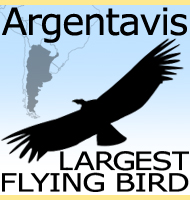 |
